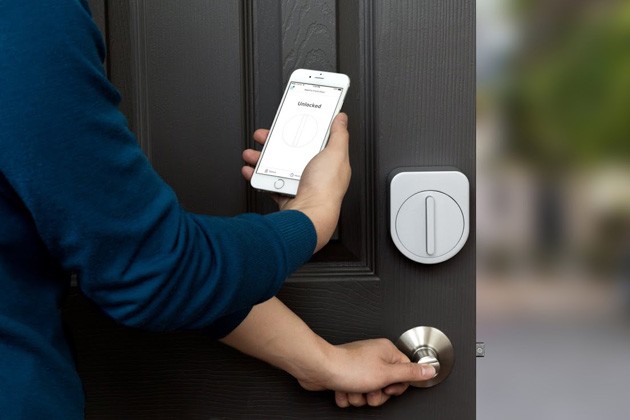Every entrepreneurs worst nightmare became a reality for Danish startup, Sesame Labs, just a few days before they were about to launch their smart lock. An US based startup beat them to the punch and launched a similar product with an identical name.
Sometimes fate plays cruel tricks and you are tempted to ask yourself “What are the odds?” This is what the entrepreneurs behind the Danish Start, Sesame Labs, are asking themselves at this moment.
They have spent the last two years on developing Sesame Smart Lock, a smart lock that can be attached on your front door and can be operated with your smartphone.
The team behind Sesame Labs include Skype investor Morten Lund, as well as a CEO with 15 years of experience in the industry. Danish architects Bjarke Ingels Group (BIG) designed the lock, who just received the prestigious job of build the new Google headquarters in Mountain View, California.
But even having big names like that backing them up, was not enough to secure them against what most entrepreneurs fear the most, but only a few ever experience.
Sesame Labs has just launched its smart lock on the crowdfunding platform, IndieGoGo, but a new product appeared out of nowhere on the rivaling crowdfunding service, Kickstarter, which made the team behind Sesame Labs lose their breath.
The rivaling product is called Sesame as well and is an easy to use smart lock that can be attached to your front door. They have managed to raise DKK 2.3 million Kickstarter in just a few days, with a goal of just DKK 650.000 and they still have 56 days left of their crowdfunding campaign.
”It is simply too crazy, a wild coincidence. My first thought was that this was very unfortunate. We are entering a dialogue with them to find out what we
are going to do. We have a trademark and is in the process of examining whether we have the right before them. We prefer to have a peaceful solution to this problem,” says Dan Nielsen, Project manager at Sesame labs.
Unlikely event or inevitable development?
Although it may seem unlikely, that two startups launch with the same name while offering almost identical products, is there still a certain logic behind it.
Smart locks has evolved in the last couple of years from what we call the first generation, which typically appeal to more tech savvy, is harder to use and with less focus on the design.
The market had been quiet for a while, until the launch of the two Sesame smart locks. The Sesame smart locks is the second generation, and promises to do the same thing for smart locks, as iPhone did for smartphones. They are easier to install and have a nice design, making it possible for them to become a mainstream consumer product.
The name ‘Sesame‘ refers to the magical phrase “Open Sesame up” from the story of ‘Alibaba and the forty thieves‘, and even through it was BIG who got the idea for the name in Denmark, it is not inconceivable that others should get the same association to the ‘magical lock‘.
The Danish entrepreneurs are still trying to figure out how to handle the situation, but they also see some positive things about the situation:
“It is an interesting opportunity that we now have ´Sesame against Sesame´ in the market. It is great to see that there are low-cost solutions out there, and that people on Kickstarter are interested in smart locks. In our case, we have more functionality and design than you find in their product,” says Dan Nielsen.
The Danish Sesame is coming for the Scandinavian and US market, where the rival is built primarily for the latter. Both smart locks boasts of being easy to install, but the Americans solution requires an additional Wi-Fi dongle to connect from long distances. This functionality is already build into the Danish solution that also comes in several specific materials, among other things, bronze, copper, wood and porcelain.
“The technology is not enough anymore for second generation smart locks. The product has to be interesting in itself. Our product is not only a smart lock; it is also a designer furniture.”– Dan Nielsen
The Danish invention is thus only one example of a larger trend in the consumer electronics market according to Dan Nielsen:
“Home automation is about to move into a new era, where you have to make products that must be a more integral part of the home,” he says while mentioning Apple’s Airport Express as an example of how routers are gone from being big and bulky to becoming beautiful part of the home.
Bluetooth innovation behind the development of smart locks
The entrepreneurs behind the Danish smart lock are expecting that you can use their lock for one year before you have to change the batteries. The reason behind this is that it does not take a lot of power, to communicate with the lock. The biggest part of the power intake is for the engine, which have to turn the lock.
“The engine only uses a lot of power for short amount of times, so we used some special lithium batteries that fit the pattern,” says Dan Nielsen.
Since the low energy Bluetooth became a standard in 2010, has it been possible for the electronics to be in constant connection via Bluetooth without consuming a lot of power.
The combination of Wi-Fi and Bluetooth gives special opportunities for smart locks. You can ‘mate‘ a phone with the lock via Bluetooth, and then the lock will recognize the individual phone and know if it is authorized to open or not.
This means that you can give friends and family access to your home, and they only need to bring their smartphone to enter. You can also easily retract the invitation, without having to change your lock or physically take back a key.
“If you have an ex-girlfriend that you don’t want to enter, then you simply remove her access to the smart lock,” says Dan Nielsen
This article is written based on an article from Version2.dk
 Nordic Startup News Early Stage Startup News From The Nordics
Nordic Startup News Early Stage Startup News From The Nordics


